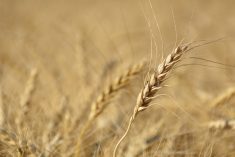The heavy, hanging heads of sunflowers are usually a happy post-harvest sight in the Red River Valley.
But this year they’re hanging over farmers.
“I’d like to believe that there’s 50 percent out there that maybe isn’t that bad,” said Mike Marion, general manager of Sabourin Seed Service in St. Jean Baptiste, Man.
“But there’s probably 50 percent out there that won’t even make bird food.”
Sunflower crops were mauled by early season moisture and late season frost. Marketers say early seeded sunflowers were hit hard by sclerotinia when incessant rains and humid air let the fungal infection romp for weeks.
Read Also

Chinese offer complicates canola marketing
Recently the Chinese ambassador indicated that there would be a potential deal between Canada and China regarding the current tariff war.
Because of saturated soils, many sunflower crops were seeded late and were devastated by the frosts of September and October.
Farmers who seeded late were banking on a hot spell in the summer to speed the crop along, but it never came.
“It was one of the most unusual summers I can ever remember,” said Grant Fehr, manager of Keystone Grain in Winkler, Man.
Usually by the end of September, the fields have received 2,600-2,800 heat units, but this summer they got 2,200, too few for many fields to mature in time.
The oilseed and confectionary sunflower markets will be clamouring for supply, but Fehr thinks few farmers will have much to sell.
“I think we’re going to have short supply, but the quality’s going to be very hard to work with,” said Fehr.
Confectionary sunflowers are sold for human consumption. Oilseed sunflowers are sold for crushing into oil and for bird seed. This year’s oilseed sunflower price will be set by the bird food buyers, Fehr said, because the crushers will back away from the crop.
“In a long market, crushing dictates price. In a short market, bird food dictates price,” said Fehr.
Last year crushers reduced their exposure to high-priced North American sunflower seeds by importing raw South American oil to meet their needs.
But bird food distributors, such as Superstore, Costco and Home Depot, are not willing to leave products off their shelves, so they’ll bid up prices until they can get enough.
Low quality confectionary sunflowers can often be sold to bird food distributors, but this year’s crop is so bad that most will not make even those specifications.
If sunflowers can’t make either human or bird quality, “you’d might as well put a disc in there,” said Marion.
Fehr said producers need to work closely with their processor and buyer to see whether their crop can be saved.
If the buyer doesn’t see a salvageable crop, get ready to turn it in.
“If he doesn’t think he can clean it, get your processor to talk to crop insurance about writing the field off as being unmarketable,” said Fehr.
“We’re doing that with edible beans right now.”
The full extent of losses to this year’s crop is not known, but will be soon.
“Producers have not been able to get into their fields, but once we’re in the fields we’ll have a better idea of what’s out there,” said Fehr.















